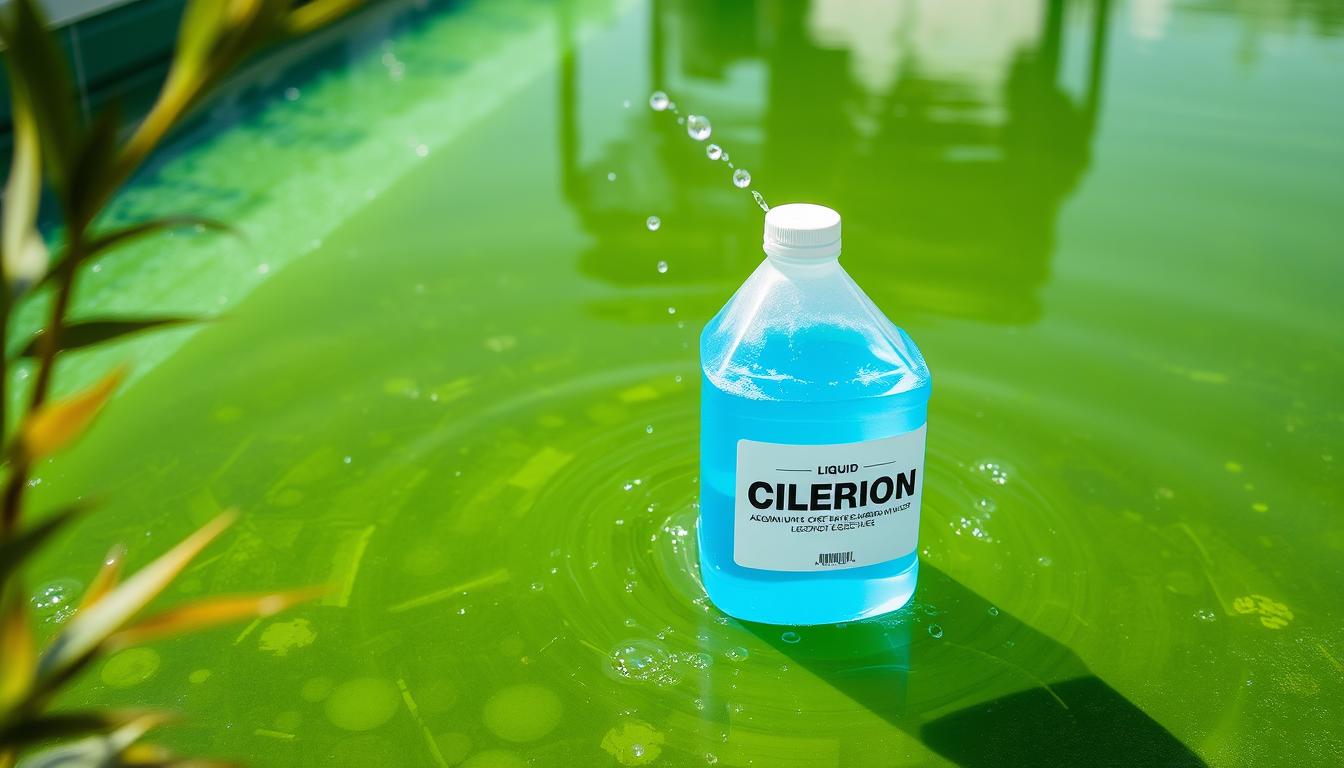
Green, murky water can ruin your pool day. Algae growth turns a sparkling oasis into a mess. But liquid chlorine shock treatment can save your pool!
This method quickly restores clear water. It raises free chlorine levels to kill bacteria and algae. Your pool will look fresh and inviting again.
Liquid chlorine is a powerful solution for algae-filled pools. It spreads evenly and works fast. With the right dose, you’ll say goodbye to green water.
Proper shock treatment prevents future algae growth too. It keeps your pool looking great all summer long. Get ready for endless fun in the sun!
Key Takeaways
- Liquid chlorine shock treatment is an effective way to combat algae growth in pools
- Shocking your pool involves adding a high concentration of chlorine to rapidly increase free chlorine levels
- Liquid chlorine disperses evenly and quickly, making it ideal for treating algae-filled pools
- Using the correct dosage of liquid chlorine shock is crucial for restoring crystal-clear water
- Proper shock treatment can prevent future algae growth and keep your pool looking its best
Understanding Pool Shock and Algae Growth
Pool shock is vital for keeping your swimming pool clean and safe. It fights contaminants and algae growth. Let’s explore pool shock basics and signs of algae in your pool.
What is Pool Shock?
Pool shock is a strong chlorine or non-chlorine sanitizer. It kills bacteria, chloramines, algae, and other unwanted substances in pool water. Shocking raises chlorine levels to destroy contaminants.
This results in cleaner, safer, and more inviting water. For routine maintenance, add one pound of shock per 10,000 gallons of pool water.
Types of Pool Shock
There are several types of pool shock available, each with its own advantages and considerations:
- Sodium hypochlorite: This liquid chlorine shock is fast-acting and effective, but it can raise the pH level of your pool water.
- Calcium hypochlorite: Available in granular or tablet form, this shock is slower to dissolve but provides a more stable chlorine level over time.
- Chlorine-free oxidizing shocks: These non-chlorine shocks are ideal for those with sensitivity to chlorine or for use in indoor pools, as they don’t produce harsh fumes.
Signs of Algae Growth in Pools
Algae often grows in pools during warm weather or with poor maintenance. Here are some signs of algae bloom in your pool:
- Green water: A pool with a green tint is a clear indication of algae growth, with darker shades signifying a more severe infestation.
- Low chlorine levels: When chlorine levels drop below the recommended range of 1 to 3 parts per million (ppm), algae can thrive and multiply rapidly.
- Ineffective chlorine: If your pool water remains cloudy or green despite regular chlorine additions, it may be due to high levels of chloramines or other contaminants that render the chlorine less effective.
- Cloudy pool water: Cloudy water can be a sign of poor filtration and low sanitizer levels, providing an ideal environment for algae growth.
A pH level of 7.2 makes chlorine 66% effective, while a pH level of 7.8 reduces its effectiveness to 22%.
Regular pool shocking is key to clean, safe, and algae-free water. Shock frequency depends on pool use and environment. Weekly or bi-weekly treatments are common.
| Algae Growth Severity | Recommended Chlorine Shock Level (ppm) |
|---|---|
| Mild | 6-10 |
| Moderate | 20-30 |
| Severe | 40-60 |
Know pool shock’s role and spot algae growth signs. Take action to keep your pool clean, clear, and fun for everyone.
How Much Liquid Chlorine to Shock a Pool with Algae
Proper liquid chlorine dosage is vital for effective pool maintenance. Two key factors determine the amount needed: algae growth severity and pool size. These elements guide the shock treatment process.
Determining the Severity of Algae Growth
Assess the algae growth in your pool before calculating chlorine needs. Mild growth causes slight water discoloration. Severe cases create thick, green or black patches on surfaces.
These severe cases also reduce water clarity significantly. Understanding the problem’s extent helps determine the right shock treatment dosage.
Calculating the Right Amount of Liquid Chlorine Shock
Consider algae severity and pool size to calculate the chlorine dosage. For weekly shock treatment, use 0.25–1.5 gallons of Leslie’s Liquid Chlorine per 5,000–30,000 gallons.
Severe algae may require double or quadruple this amount. Maintain free available chlorine levels of 1–4 ppm for optimal algae prevention.
Applying Liquid Chlorine Shock to Your Pool
Run your pool pump continuously when applying shock. This ensures proper circulation and prevents liner bleaching. Pour measured chlorine around the pool’s edge, focusing on visible algae areas.
Test water regularly after shocking to monitor chlorine levels. Maintain balanced pool chemistry. Repeat the process until all algae is eliminated and your pool looks pristine.







